

Table of contents
- When is the best time?
- Why is a pruning so tricky despite good cut compatibility?
- Ornamental apple tree - instructions for crown pruning and trunk care
- Guide to pruning as a solitary garden shrub
- Cut the ornamental hedge correctly – you should pay attention to this
- Rejuvenation pruning on shrubs and treetops - How to do it right
- Crabapple bonsai - instructions for pruning care
In order for a crab apple to present itself in the garden as a furious triad of fragrant blossoms, lush green leaves and picturesque fruit decoration, it depends on the right cut. You don't have to pore over demanding treatises on professional fruit tree pruning. After reading this guide, you will be familiar with all aspects of cutting.
When is the best time?
Robust pruning tolerance allows you to make minor corrections throughout the growing season. For more extensive interventions, various times have proven useful in practice. The following overview summarizes the best dates:
- Shape and maintenance cuts on the shrub and tree crown: between November and March
- Pruning and caring for the trunk of the ornamental apple tree: between June and September
- Rejuvenation pruning: between January and March
- Pruning of bare-root hedge shrubs: after planting in autumn or in the following spring
- Garden bonsai pruning: after the flowering period, at the latest in autumn before the first frost
By choosing the exact date for the shape and maintenance cut on the bush and crown, you can influence further growth. If your ornamental apple is struggling with weak growth, the best time to cut back is between November and January. If you want to reduce the growth rate, the ideal time window is open in February and March.
Why is a pruning so tricky despite good cut compatibility?
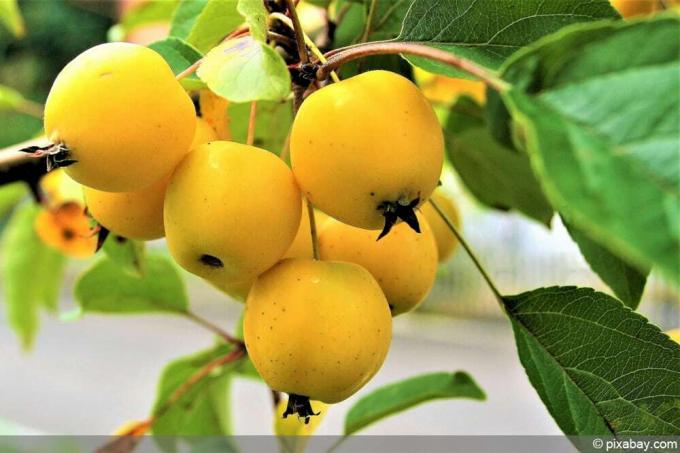
Whenever you cut your ornamental apple, a more or less large amount of buds, flowers or fruits falls victim to the scissors. Unfortunately, the good-natured pruning tolerance of the plant does not change that. Shortly after the end of the flowering period, the buds for the next year are created. If you want to forestall this process with a summer pruning, remove the plants for the autumn fruit decoration with the withered flowers. Follow the times recommended here for shape and maintenance pruning during the leafless period, and at least keep enjoying the colorful little apples.
There is no ideal solution to the floral dilemma. A restrained incision has emerged as the best solution in practice. Cut a decorative apple according to the rule of thumb: as much as necessary - as little as possible.
Tip:
The pretty, small fruits are not poisonous. However, ornamental apples are not suitable for fresh consumption due to their bitter taste. In some regions resourceful housewives use it to make jelly or jam. The colourful, firm little apples are also suitable as handicraft material for imaginative autumn wreaths.
Ornamental apple tree - instructions for crown pruning and trunk care
As a house tree, ornamental apples are held in high esteem in private gardens. From the magnificent spring bloom to a densely leafy crown in summer to the bright fruits in autumn, the ornamental tree proves to be a decorative reflection of the seasons. To keep it that way, scissors and saws should be used according to these instructions:
- In winter, prune dead, damaged and stunted branches
- Cut off these shoots at the base without damaging the branch ring
- Cut back branches that are too long and too low
- Set the scissors at a distance of 3 mm to a bud
- In summer, cut or tear off side shoots below the crown of the trunk
To remove a thick branch more than 5 cm in diameter, proceed in stages. At a distance of 10 to 20 cm from the trunk, saw the shoot from below to the middle. Now move the saw a few centimeters and cut from above until the branch breaks off. Support the remaining stub with your hand and position the saw in such a way that the bulging knot ring is not damaged during the cut. Please do not leave any 'coat hooks'. At this point, the wood dries back, dies and offers a welcome target for pathogens.
Guide to pruning as a solitary garden shrub
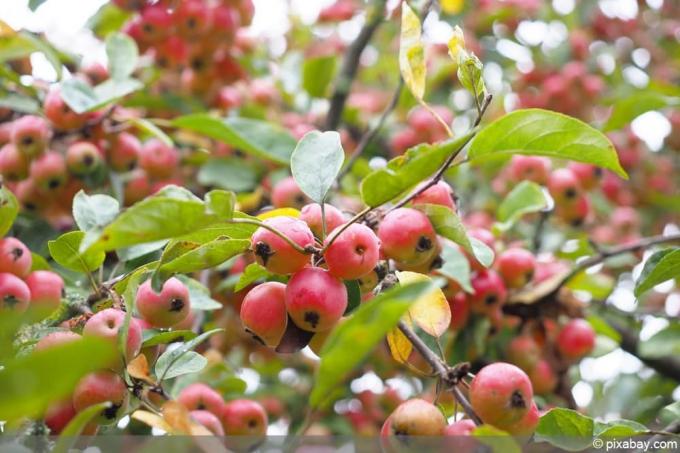
Crabapple hybrids such as 'Evereste' or 'Golden Hornet' are the jewels among the solitary flowering and fruit ornamental shrubs. The rapid growth of up to 80 cm per year makes pruning unavoidable at the latest when the spatial dimensions in the garden are exceeded. Annual thinning effectively prevents balding from the inside out. This guide summarizes what needs to be considered in the context of hair care:
- Thin out deadwood every late winter
- From the fifth year cut off the two oldest shoots at the base
- If necessary, shorten shoots by a maximum of one third
- Always cut close to a bud, leaf or dormant eye
If an ornamental apple grows over your head as a large shrub during the summer, shorten the branches to the desired height immediately after flowering. More than a third of the foliage should not be removed during the growing season to avoid weakening the plant. In this case, wait for a time after St. John's Day, because the subsequent budding will be less from this point in time.
Tip:
Almost all ornamental apples are grafted on wild apple (Malus sylvestris). Cheeky wild shoots sprout from this base all year round to overgrow the noble part of the plant. As soon as you spot a water shooter, tear the shoot off the base with a courageous tug.
Cut the ornamental hedge correctly – you should pay attention to this
Shrubby crab apple species such as Malus floribunda and Malus toringo sargentii are planted in rows to form a magnificent privacy hedge. Both of these crabapples flower and fruit well even after a topiary. By purchasing bare-root goods from the nursery, you can significantly reduce the purchase price. Apart from the fixed planting season between October and April, the only difference to high-priced container goods is a plant cut. With regard to the subsequent pruning care, bare-root and potted ornamental apple bushes pull together. How to proceed correctly:
- Cut back bare-root young plants by a third after planting
- Potted young bushes are not pruned
- From the third year of growth, thin out the hedge thoroughly every late winter
- Cut off deadwood, weak and inward-pointing shoots at the base
So that a head-high, densely branched hedge quickly forms, trim the shrubs during the leafless period from November to January. At this point, pruning gives growth extra momentum. Only when the hedge has reached its final height or the annual growth is to be slowed down do you grab the scissors between February and March. Please note that the harder you cut back the shoots, the more buds you will remove. Therefore, limit the amount of cuttings to what is absolutely necessary if you do not want to deprive yourself of this year's flowering splendor.
Make sure that the cut has an advantageous trapezoidal shape. Because a decorative apple hedge tapers slightly from bottom to top, the sunlight reaches deep into the interior of the bushes. Because of this, the shoots can produce leaves close to the ground, so that the hedge does not become bare.
Rejuvenation pruning on shrubs and treetops - How to do it right
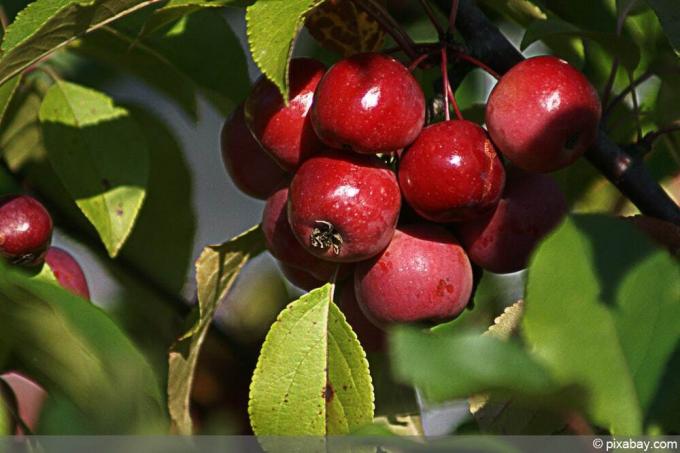
In order not to spoil the beautiful flowers and the wonderful fruit decoration, careful home gardeners do not cut the ornamental apple at all. As a result, the shrub or crown will age. The increasing amount of deadwood shades the shoots so that no leaves and flowers can thrive here. With a taper cut you fix the problem. That is how it goes:
- The best time is a frost-free day in winter
- In the first step, cut off all dead branches at the base
- Thin out weak, diseased and damaged shoots
- Cut back the remaining main shoots to 30 to 50 cm
Long rods sprout from this basic structure from spring to autumn. Leave three to four strong side shoots on each main branch. Shorten these by a third or half of their length. Position the scissors over an outward-facing bud to direct further branching in the right direction. It is important to note that you cut back these young shoots to different heights so that a harmonious shape of bush and crown can develop. Central branches should overhang lateral branches by a few centimetres.
Tip:
Means for wound closure are no longer up to date. Sealing larger cuts with an airtight paste has been proven to be counterproductive. The only exception are wounds with the diameter of a 2 euro coin and larger, provided they occur in the middle of winter. Just apply a thin layer of tree wax to the edges of the wound to protect the cambium wood, which is sensitive to frost, until spring.
Crabapple bonsai - instructions for pruning care
In the small garden and on the balcony, graceful crabapple bonsai varieties trump with lavish abundance of flowers and autumnal crabapples. While their imposing counterparts grow up to 6 meters high and 2 meters wide, dwarf varieties remain at a height of 1 to 1.5 meters. In addition, the annual growth is limited to a leisurely 15 to 20 cm, so that pruning the branches is usually not necessary. The focus of cutting care is annual thinning. If you cut dead twigs out of the crown or bush in autumn or winter, a lavish bloom will set the scene again next spring.
 Home editorial office
Home editorial office
Learn more about pruning

Eucalyptus dried up: cut back now?
When a eucalyptus dries up, some owners immediately think of cutting it back. Because they want to see fresh green bud quickly. The chances of that happening may be good. But one thing must not be left out: research into the causes! Otherwise a new cycle of drying up and cutting begins.
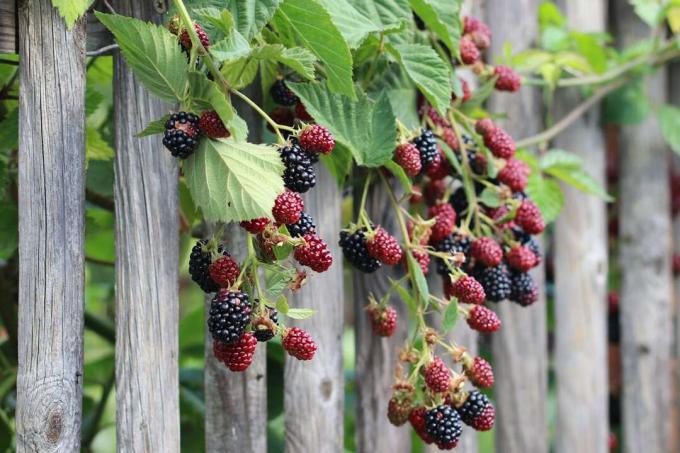
Cut blackberries: Instructions for the right cut
Bramble branches only bear fruit for one summer, after which they are used up and die off in winter. It's a good thing that new canes grow back in time for the following year. Cutting care means: What no longer supports should be removed, young rods must be optimally trained.

cutting snowball | 13 tips for pruning
When it comes to snowballs (Viburnum), the opinions of numerous hobby gardeners differ when it comes to cutting. Main reason against pruning: Destruction of the natural appearance by pruning. Find out now when it is unavoidable and which tips should be heeded.

Cutting sage: 6 tips for cutting back
Cutting measures and their ideal time depend on the species of sage plants, because they have differentiated ways of life. There are woody and herbaceous representatives that require different attention. In order to carry out the measures, a basic set of tools is helpful.

Pruning hydrangeas: when is the right time?
Hydrangeas are a real beauty because of their flowers. In the long term, however, the flowering power is only maintained if regular pruning takes place. Because cutting off withered or dried plant parts offers protection. The following guide shows when this measure should be taken.
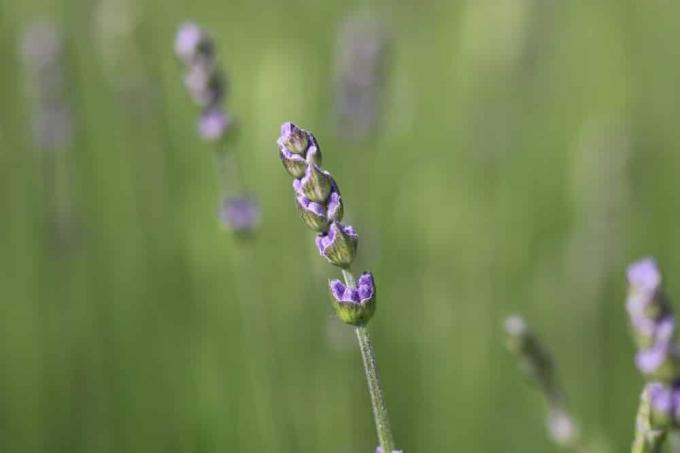
Cutting Lavender | When is the best time?
Lavender is a popular perennial, but difficult to cut. Without regular pruning, the shrub becomes lignified and less robust. Choosing the right time is important for pruning. When to cut depends on the use of the perennials.
